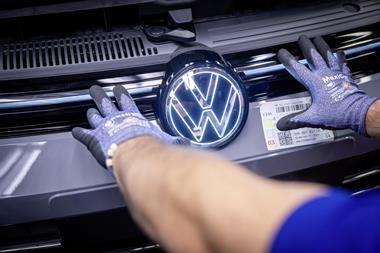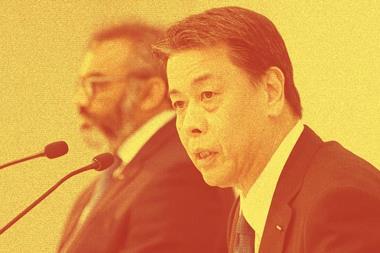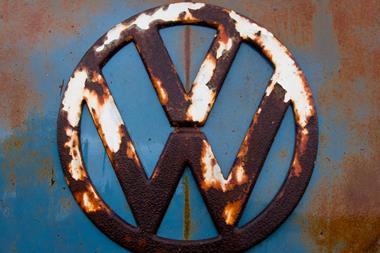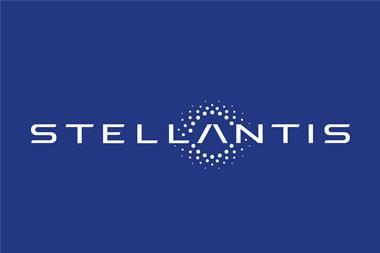
GM’s Martin Apfel and Ford’s Joe Hinrichs describe how these two global giants are moving forward with plans to turn Thailand into a regional manufacturing hub
The sign above the entrance to the Eastern Seaboard Industrial Estate in Rayong, Thailand, proclaims it to be ‘The Detroit of the East’.
Reviewing the anaemic state of automotive manufacturing activities in Michigan, it’s debatable whether this is a desirable comparison, but there’s no doubting the sentiment, as the sprawling park is home to both the Auto Alliance Thailand (AAT) joint-venture between Mazda and Ford, the General Motors Thailand plant, and a new Ford plant, still under construction.
In March this year, automotive sales in Thailand posted a year-on-year increase of 44%. In order to supply such phenomenal market growth, which extends beyond Thailand to other member countries of the ASEAN (Association of South-Eastern Asian Nations) trading group, both GM and Ford are expanding their respective production facilities. But things were not always so healthy, as Martin Apfel, President of General Motors Thailand/South-East Asia describes: “Going back to 2009, our operation in Thailand was on the edge, we had capital fees, and all the programmes we were launching were frozen until we could secure sufficient financing.”
According to Apfel, it was his predecessor, Steve Carlisle, now head of global product planning at GM, who managed to secure the future of GM’s in-country operations by working with the government to line up a consortium of banks willing to supply the required financing to support the company’s business plan. “It was a near-death experience for the operation,” says Apfel. “Everything you see now, the South-East Asia headquarters, all the product in the pipeline, it wouldn’t be here. Maybe [GM Thailand] would be a distributor selling some product out of Korea.”
While North America is the leading market for pickup sales, Thailand is the second-largest global market for these light trucks. The ‘product in the pipeline’, which was financed by a locally-procured loan deal signed in February 2010, is part of a package that includes local production of the Cruze and Aveo CNG saloons and the second-generation Colorado pickup. Such is the importance of the model, Thailand was selected as the site for the global launch of the new pickup, the platform of which will also serve as the basis for an SUV model.
Until the new Colorado enters production, GM Thailand will continue to produce Isuzu pickups (rebadged firstgeneration Colorado) under contract at its Rayong facility, with both GM and Isuzu models using diesel engines supplied by the Japanese company. A further portion of the financing package supported construction and implementation of a brand new engine facility at Rayong, and although Apfel is unwilling to disclose exactly which engine will be first delivered by this new addition, it’s likely to be a new diesel engine for the second-generation Colorado. He adds that there are further advantages to producing engines in Thailand.
“This is our first engine plant in south-east Asia and it’s a huge opportunity. First, it helps from a cost perspective, tax reductions and the freedom to export [within ASEAN].
Second, if you visit the engine part suppliers, they’re not newbies. These suppliers have been in-country supplying Honda, Toyota, Isuzu; they have enormous competence in that area. So instead of ‘we know what we’re doing, we’ve done engines all over the world’, we’re tapping into that pool of experience. There are so many good things we can learn from the suppliers, how to improve, how to be a good customer.”
Apfel continues by saying that it is essential to take this knowledge onboard, as while the engine plant employees were subjected to a rigorous selection process, no one up to the new plant manager has ever done exactly what they’re doing now. “For some of the positions, we went through 30 interviews to get the right person. That’s probably excessive, but we never lowered the standard. We’ve brought people here who are good teachers, people that don’t just start up a plant but have a passion to leave something behind.”
From the outside looking in, changes at both GM and Ford with regards to their respective build partners, Isuzu and Mazda, would point to the individual relationships winding down. As mentioned, the local production deal with Isuzu will end with the introduction of the second-generation Colorado in late 2011, while Ford has been slowly selling off its stake in Mazda. How will these changes affect the working partnerships?
Apfel: “The way we look at that is we have divested a lot of our shareholding in FHI Isuzu, prior to New GM.
The way to perceive these relationships is that it’s not like signing up on their dance card for life and you owe them a dance everywhere in the world. It’s a very flexible way of handling the relationship. Isuzu is critical in South America, the southern half of Africa. Does that mean we have to do business together everywhere we are? No, it doesn’t. So you’ll see our business together expand and contract where it makes sense. Isuzu is a long-term partner of GM, it’s a very vibrant partnership.”
With regards to Mazda, which acts as a contract manufacturer producing the Fiesta and Ranger for Ford at the AAT facility, alongside its own Mazda2, Mazda3 and BT-50 models, Joe Hinrichs, Group Vice President and President Asia Pacific and Africa, has a similar viewpoint. “We still have a strong partnership with Mazda. Mazda and Ford are going their own ways on product and powertrain plans, but we’re still very strong. We have a 30-year plus history, the JV we have in Thailand is at full capacity and will continue.
“Our relationship with Mazda is much deeper than it is with other OEMs, such as Fiat, which builds the Ka in Tychy, Poland. The relationship is deeper than just ownership of stock. We’re still one of the top five shareholders in Mazda, but we’ll work together in a way that works for both of us.”
While GM is in the final stages of bringing a new engine plant online, Ford will soon complete a new, wholly-owned facility in Rayong; start-of-production for the thirdgeneration Focus is scheduled for 2012. Hinrichs points out that this addition will make Thailand one of the carmaker’s key production hubs. “We’ve made some major investments in Thailand recently, $300m at the AAT JV, $500m for Fiesta production and now we’re building the new plant, which is $450m. With China and India, Thailand is setting up nicely to be another large main hub in the Asia/Africa region.
“That’s been done with a long-term view. The auto industry is strong here, manufacturing has a strong presence. The supply base is here, good logistics, and the government has been very supportive over a long period of time, so it’s a great export hub for us, as well as a manufacturing centre.”
Even Thailand’s current political uncertainty will not deter Ford or GM from completing their individual expansion plans. Hinrichs echoes the thoughts of both executives: “We’ve seen the growth of the auto industry and supply base. The government, under different leaders and different parties, has been consistently supportive of the industry and they have set the foundation for this manufacturing auto industry to be here, so it has makes sense for us. We’ll continue to be here.”
While government support plays a key role in developing financing and infrastructure development, the help that new manufacturing opportunities receive is not surprising, particularly when taking into account that the automotive industry in Thailand represents approximately 15% of the country’s GDP.

Business has radically changed since GM Thailand’s brush with closure in 2009. Martin Apfel says that based on sales, which were better than those outlined in the provenance of the banks, the carmaker got an agreement that allowed it to reinvest some of that cash flow into even more product, which in turn has made the business considerably more investable.
“The auto industry is a ‘momentum’ business,” says Apfel.
“When you’re sliding down, you’re on a slippery slope, you don’t stop mid-way. Once you’re on the upswing, the early decisions determine the trajectory. If you look at January, February this year in Thailand, we’re 80% above Jan, Feb 2010, which was a growth year over 2009. It’s far beyond what we expected, and beyond what we committed. So the trajectory is exactly where we want it.”
 Case in point was the recent introduction of the Chevrolet Aveo CNG, GM’s first entry in the small car segment with an ex-factory CNG fuel system. Initial dealer response in December 2010 was lukewarm, with orders expected to be around 100 units per month. Then came the two annual carshows, where combined orders for the Aveo, the newlyintroduced Cruze and Captiva SUV with the new LA50 engine totalled 5.1% of all show bookings; to put that in perspective, company market share in 2010 was 2.5%.
Case in point was the recent introduction of the Chevrolet Aveo CNG, GM’s first entry in the small car segment with an ex-factory CNG fuel system. Initial dealer response in December 2010 was lukewarm, with orders expected to be around 100 units per month. Then came the two annual carshows, where combined orders for the Aveo, the newlyintroduced Cruze and Captiva SUV with the new LA50 engine totalled 5.1% of all show bookings; to put that in perspective, company market share in 2010 was 2.5%.
Anticipated conversion of show bookings to sales in Thailand is between 70 and 80% - this was the momentum. “In the January ordering round, dealer bookings for the Aveo CNG were at the 700-unit level,” says Apfel. “Every time I’m out with the dealers, they’re clammering for more product. Alleluia!”
According to Ford’s Joe Hinrichs, the carmaker will launch eight new vehicles in the ASEAN region by 2015. These will be based on global platforms developed as part of the ‘One Ford’ strategy. The added capacity in Thailand will help bring these vehicles to a region Ford is expecting to deliver 70% of its profits over the next decade. “People here are coming of age and per-capita income is increasing to levels where people can afford more vehicles. There are a lot of motorcycles around here; those people are now looking to buy cars. It’s a market explosion.”
Rather than invest in expanding production at the AAT plant and build the new production facility for the Focus, could Chinese production have delivered the required vehicles to support market demand?
“There are a lot of free-trade agreements between ASEAN countries that make it better to have manufacturing within the region. China is so big and growing so fast, many of us are having trouble keeping up with the growth that’s occurring there. You really need to decouple it. China’s auto industry is already 18m strong, bigger than Europe, so it requires dedicated attention; it feeds off its own growth.”
Hinrichs points out that there is a critical point in personal income, equivalent to about $6,000, where the population starts to drive the local auto industry. “It’s been true in many countries around the world, and you’re seeing it many of countries in Asia-Pacific, where per-capita income is just reaching that point.”
He goes on to explain that unlike China, which is a cash market, Thailand is largely a credit market, which creates a different market dynamic. While the availability of affordable credit has helped overall sales, in much the same way that it has in countries such as Brazil, it’s still the increasing per-capita incomes (rising inline with inflation) that are underwriting market growth.
But with big growth come equally big crashes; what’s the plan of action when the market is saturated? In his reply, Hinrichs essentially says that the Thai market is so deep that this will not be a problem for the foreseeable future. “The density level on a per-1,000 people level is so low that there is a lot of room for integration of an automobile into people’s lives. In some ASEAN countries, you’ve got 20% of the people that can afford a car still driving a two-wheeled vehicle. Combine this with a growing population and this is why we’re doing what we’re doing.”
The recent success of GM Thailand has allowed the company to expand, adding capacity and new products, but in many cases – even in established markets – increased output has served to highlight weaknesses in the supply chain. Martin Apfel, on how GM handles part delivery: “Once we cut a contract with a supplier our basic principal is this, they avail themselves with a tool that we own of a certain capacity, operating an eight-shift, five-day working pattern. We also ask them to be able to deliver an additional 20% without further investment. That’s the first step. We work with the suppliers so they optimise their operating pattern, and then we see whether the tool can do more. If not, we can put in a second tool, which is easy as it’s identical to the first.
But you’ve got to go case-by-case, you’ve got to tick all the boxes. It’s about what gets you to the right output, then you rightsize; it’s all about optimisation.
“Once you put it together, it’s a case of what’s right from a supplier perspective, and once you put it together, what’s right from a production perspective, what is the market demand. You may want to be a little short in the market. I never have a problem being one car short to the market. One of our things is confident pricing. We will not buy share, we will not give away cars. We are about making healthy margins.”
This is atypical for the Chevrolet brand, which particularly in North America, was well known for offering buyer incentives and discounts on even new models. Now, GM Thailand appears to be following the same selling strategy as the former Saturn division, where the sticker price is what the customer pays, with little room for negotiation.
There’s also the case of having to entice suppliers to work with you, which is not as easy as it sounds when most global carmaker have a presence in Thailand. But Apfel says that this comes down to confidence, in the brand, the products and the business plan.
“We’ve been very parsimonious with our spending, we’ve held just a couple of targeted events, like the launch of the Cruze,” says Apfel, to which he must now add the launch of the second-generation Colorado, an incredibly important vehicle for Chevrolet considering the size of the pickup market in Thailand. “This has made us very confident. We can go to the bankers with business results and say ‘we believe’. We can go to the suppliers, show the product tables and how the business will help their pocketbooks and they believe.
“We build what we sell and we source what we build. We want to significantly increase our penetration into the value chain, so we’re going to higher, local vertical integration, more localization.” Beyond new models, this also extends to the new engine, which will start at 40% localisation, with a later goal of comprising 55% locally-sourced parts.
When Martin Apfel took over as GM’s ASEAN chief, the release announcing his new role included the forecast that within three years, General Motors would increase local market share to 10% - at the time the company commanded a 2.5% share. He still believes that this is achievable, and considering recent company performance, who can blame him?
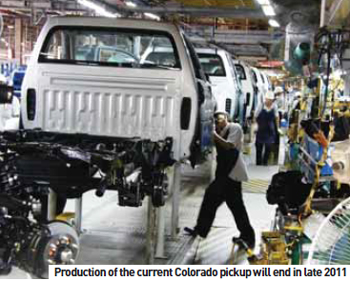 “It’s a wonderful experience to be here at this time. I’ve spent most of my professional career restructuring, which is a euphemism for cutting, making things right-sized. So running the bottom line, P&L – and growing – and not being bashful about it, while getting a positive response from the team, whether it’s dealers, suppliers, employees, it’s fantastic.”
“It’s a wonderful experience to be here at this time. I’ve spent most of my professional career restructuring, which is a euphemism for cutting, making things right-sized. So running the bottom line, P&L – and growing – and not being bashful about it, while getting a positive response from the team, whether it’s dealers, suppliers, employees, it’s fantastic.”
Rather surprisingly, financing for the new products and expanded production capability has not used any North American money. Instead, financing was sourced through local banks, who were clearly convinced by the company’s plans and performance.
“Business is about free cash flow. If you recall, when [GM] went into Chapter 11 in the US, 80% of our functional metrics were in the green. This is a paradigm shift, there is a huge difference in having a full order book, a fully-utilized plant and positive cash flow. The bottom line follows once we do the right thing in the market.”
Equally importantly, says Apfel, is maintaining customer perceptions of the brand, and this is directly related to quality. As part of this, information gathered from ‘single customer verbatims’ is analyzed and fed back to the line for instant actioning. This is based not on repeat problems, but on a single negative report.
“I don’t need a repeat. It’s zero tolerance. If there’s one problem with quality, we can go through the ‘diamond sweep’ to solve the problem. Did you have a standard, was the standard applied, did the operator execute according to standard? Then, if it was completed to standard, we’d have to look at changing the standard, which could be on the control side or on the operations side. Nothing on the line is set in stone.”
In many ways, Thailand is a surprising place. Although there can be some terrible traffic jams in Bangkok, the overall infrastructure, road and public transit systems, are better than those in many other cities around the globe. For example, drive out of a European or American metropolis and a major five-lane expressway will soon trickle down to a dual carriageway. Not in Bangkok, where the expansive motorways continue for 100km ouside the city.
With regards to automotive production, both GM and Ford have in-country plants comparable to any other which the carmakers operate around the world, largely a result of the respective global equipment purchasing policies and manufacturing systems. But while both carmakers have made giant leaps in product quality, particularly GM with the Chevrolet Cruze, it is local market conditions and increasing personal income that will underwrite continued success. In summation, while the Eastern Seaboard Industrial Estate bills itself as ‘The Detroit of the East’, automotive production in Thailand looks set to eclipse that of the Motor City in the very near future.































